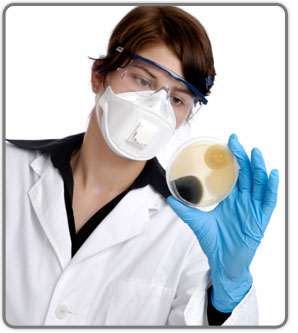Mold / mould exists everywhere to a certain extent. But, if the levels of mold in your environment exceed a certain point, it can be toxic to your health. If you suspect mold / mold contamination on your property, the first step is to immediately have your property inspected. An initial tell-tale sign of mold contamination is usually a musty odor, although this may not necessarily be noticed. Please call 1(888)-837-3161 for a FREE preliminary mold inspection.
Once the on-site mold inspection process confirms a mold problem, it is imperative to carry out laboratory mold testing, in order to ascertain the type and degree of mold contamination. This should include testing swabs of mold samples, as well as testing air samples. Swabs and air samples should be collected from all the different areas where there is mold contamination, because the type of mold can vary from room to room, and even surface to surface in the same room.
What An Accredited Mold Testing Should Test For –
1) Mycotoxins
Any accredited mold testing should do a thorough testing of the type of mycotoxins, if any, and the levels of mycotoxins, in your surroundings. Mycotoxins are toxic chemicals produced by mold. Mycotoxins can cause severe health conditions. Exposure to mycotoxins may be through contact with skin, inhalation or ingestion. In all, there are over 400 types of mycotoxins. Determining the types of mycotoxins and their quantities in your surroundings is important for gauging the exact health risks, as well as for devising an effective mold removal plan.
2) Volatile Organic Compounds
Laboratory mold testing should also include testing the air you breathe for Volatile Organic Compounds, so they can be adequately dealt with during the mold remediation process. VOCs are chemical by-products of mold. Mold / mould is known to produce many different types of volatile organic compounds. Most common among them however, are – aldehydes, alcohols, keytones and hydrocarbons. Air samples are usually drawn from your property using a vacuum cylinder. The samples are then tested using a gas chromatograph or mass spectrometer.
3) The Various Types of Mold on Your Property and The Extent of Contamination
It is possible to have infestation of multiple types of mold in your home or on your property. Determining the types of mold is very important in order to properly determine the extent of threat to your health.
Mold spores from common allergenic mold are generally not harmful in small quantities. However, even small quantities of these molds can lead to chronic health issues with long term-exposure.
Pathogenic molds are called so, because they tend to produce infections in people. There are over a 100 species of molds that are known to cause infections in human-beings. These are especially dangerous for people whose immune systems are compromised, such people infected with HIV, those on chemotherapy or immuno-suppressant drugs, people with auto-immune disorders, etc.
Toxic mold / toxic black mold is known to cause serious health problems in even the healthiest of people. Depending on the exposed person’s susceptibility, his/her degree of exposure to toxic mold and the period of time of exposure, toxic mold can result in symptoms ranging from mild to severe fatigue, respiratory or skin allergies, headaches, nausea, vomiting, to severe health problems like heart conditions, bleeding in internal organs, neurological disorders, cancer, and even death.
Mold removal is a must for any type of mold contamination, however – IF MOLD TESTING SHOWS TOXIC MOLD CONTAMINATION, MOLD REMEDITAION BY AN EXPERT IN URGENT!
Mycotoxins
Volatile Organic Compounds / VOCs
Types of Mold
Black Mold
Toxic Black Mold
Mold Testing Laboratory / laboratories
Mold Spores
Health Threat
Mold Remediation
Mold Removal
Mold Contamination / Mold Infestation







